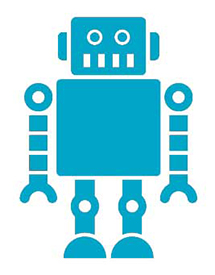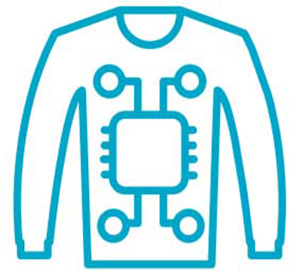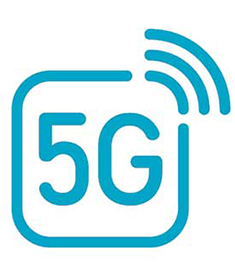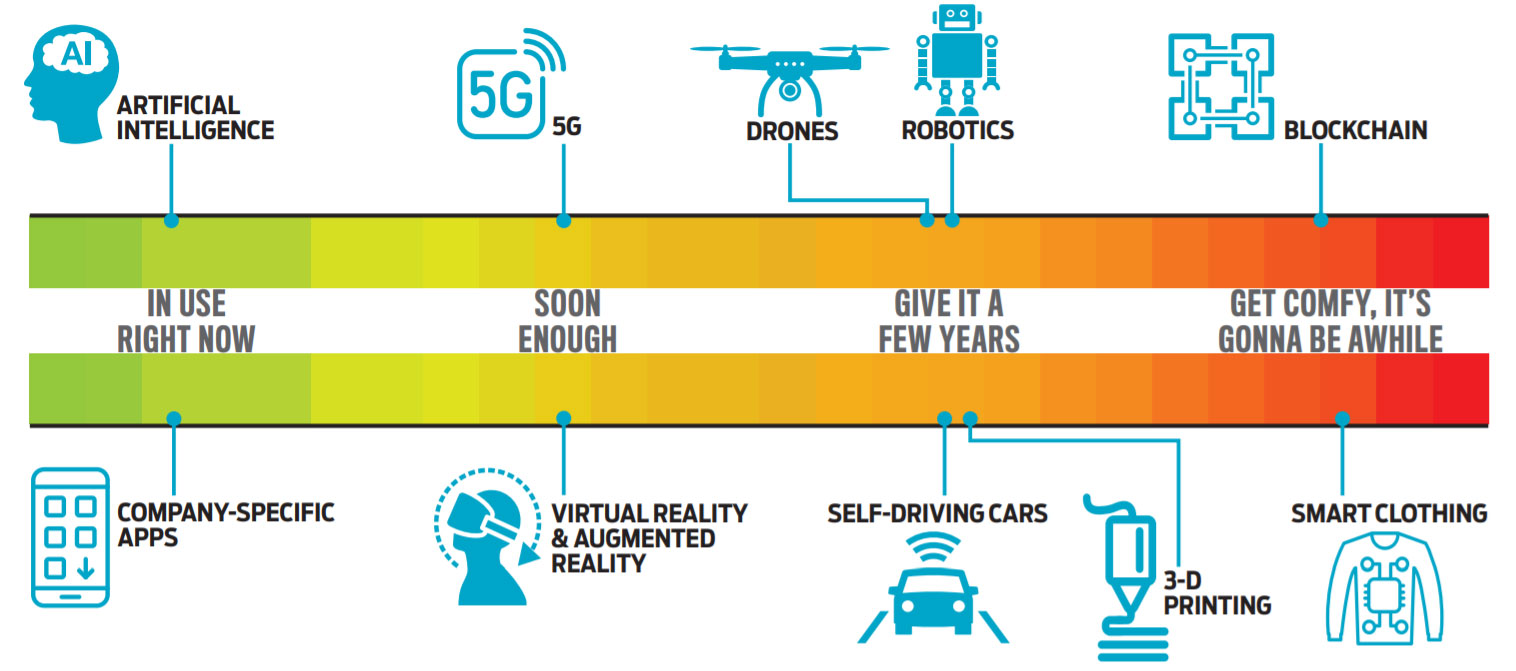May 06, 2020
10 Tech Innovations We're Still Waiting For
These 10 innovations have been on our radar for years but have yet to make a significant impact. When can we expect them to finally arrive?
The revolution is coming. Or is it? The following 10 innovations have been awaited with breathless anticipation, their arrival promising to reshape businesses and lives in exciting ways. But in many cases, we’re still waiting. Here’s the latest on each of those innovations – when we can expect them, and the impact they’ll bring when they finally break big.
1. Drones

Already used for military, photography, storm tracking and other purposes, drones have become an increasingly popular consumer category as well. But the real interest in the promo industry comes from drone delivery, which Amazon and others have been developing for years.
While last year Amazon said its Prime Air service would launch “in a matter of months,” so far that promise – along with mass adoption of drones – has yet to take off. The Federal Aviation Administration has basically grounded drones for commercial use, setting limits for weight (55 pounds), altitude (400 feet) and speed (100 mph). Drones aren’t allowed to fly at night unless they have special lighting and must stay at least five miles from airports. Companies aiming to use drones for deliveries still face two major obstacles: Drones must remain in sight of an operator and can’t be flown over people.
However, Jared Ficklin, chief creative technologist at production design consultancy Argodesign, says we’re only a few years away from those restrictions loosening up. “The technology and equipment that goes into creating drones will become so inexpensive that companies will change their current distribution strategy to deliver more products in quicker fashion,” he says. Also expect to see creative uses for drones, such as trade shows. “You’ll start to see drones approaching customers instead of companies waiting for people to pass their booth,” Ficklin says. The impact of commercial drones could be $82 billion and a 100,000-job boost to the U.S. economy by 2025, according to The Association for Unmanned Vehicle Systems International.
2. Self-Driving Cars

Despite proclamations from Elon Musk, self-driving cars have yet to arrive. Sure, great features have been developed, such as autopilot on highways, automatically breaking before a crash and keeping drivers in their lane. But we still need to physically control our cars to get to a destination.
According to some automakers, self-driving vehicles are on the horizon, maybe even next year. Uber has recently resumed testing autonomous vehicles after a crash in Arizona killed a pedestrian in 2018.
Like drones, the concept of unmanned vehicles arouses fantasies of constant, quicker deliveries. Argodesign’s Ficklin also envisions an opportunity. “Self-driving cars will be a new avenue for marketing,” he says. “Suddenly, speed becomes less of an issue. Riders will be entering a computer interface with nothing but time on their hands. Brands can fully engage with them through a digital experience.”
3. Artificial Intelligence

We’re surrounded by artificial intelligence: Siri, Alexa, Uber, Lyft, Roomba, chatbots, traffic cameras – the list goes on.
Major retail brands use AI to spot trends, understand consumer preferences, analyze price and stock movements and produce new variations of garment designs. Decorated-apparel companies are also delving into the world of AI. For example, Scalable Press (asi/87178), which does significant business in the print-on-demand space, uses AI to weed out copyright infringement.
“We compare images with good and disallowed images, we look at the text, we look at the sellers themselves and whether there are any risk factors,” says Eric Zhang, head of engineering at Scalable Press. “We put all of these factors into a statistical model, and it tells us if this should be approved, rejected or needs human moderation.” Zhang estimates that about 90% of Scalable Press’s moderation is done via AI without the need for human intervention, significantly reducing time, costs and room for error.
There will be other emerging applications for AI. For example, within the next few years, Zhang predicts more decorators will rely on AI for handling artwork, developing proofs, customer service and even customization.
4. Robotics

Industrial automation already exists through different types of machinery, especially in promo.
But the biggest challenge with robotics is handling apparel, Scalable Press’s Zhang says. “Robotics have gotten better with handling solid hard goods, but they’re not there yet with soft goods. While most robotics just replay a program, AI enables robots to perceive their environment and make novel decisions based off their perception. That’s what it takes to handle soft goods.”
That hurdle is close to being overcome thanks to Covariant, a collaboration of the world’s top AI researchers and roboticists from UC Berkeley and OpenAI. The company is building tools to allow a typical robotic arm to be a lot smarter via AI. One of the benefits, Zhang says, is that it will handle a wider range of materials. “So much of the cost of having a T-shirt screen-printed or sublimated is labor,” Zhang says. “Even replacing a small portion of the total amount of labor time in a factory will completely change the price structure for promo products. Expect to see the shift in apparel within the next few years.”
5. Virtual Reality & Augmented Reality

This tech tag team was supposed to revolutionize digital media, but it hasn’t quite lived up to the hype.
High-tech virtual headsets are now widely available, but adoption has been limited. For example, according to Superdata, Oculus shipped 354,000 units of its flagship virtual reality headset in 2018 – nice numbers, but not the virtual revolution that was promised.
Meanwhile, augmented reality – superimposing digital images, sounds and text on to the real world – has made significant strides and is popular in apps like Snapchat and Pokémon GO. Global spending on VR and AR is projected to reach nearly $19 billion in 2020, up 79% from the 2019 estimate, according to IDC. That’s still only a fraction of expected overall consumer spending on robotics systems and drones ($127.8 billion), the IDC says.
Promo firms have dabbled in VR and AR, such as having customers virtually try on garments before ordering. However, Scalable Press’s Zhang is skeptical of any major immediate impact. “In the promo products industry, I don’t see either solving problems of any magnitude, certainly not like robotics affecting the price floor of soft goods,” he says. “Even in retail, there’s curiosity from both consumers and businesses, but I haven’t seen compelling experiences or commitment to the products.”
6. Blockchain

What is blockchain? It’s a decentralized ledger operating on a cloud-based platform, as opposed to a central company that controls how information is collected or stored. It’s the process of how bitcoin and other cryptocurrencies (digital commerce) operate, revolutionizing the payment sector by eliminating the need for centralized financial institutions.
However, according to Dan Colbeth, associate product manager of SafeSave Payments at SofterWare Inc., the hype peaked in 2017 and has been slow since to recapture the buzz. “Any time there are changes in technology, especially with payments, it takes a long time for users to adapt,” Colbeth says. “We still have a lot of people in the market holding on to physical checks and cash. Even mobile payment services like Apple Pay and Google Pay aren’t being adopted as fast as we want them to.”
Colbeth estimates it will take at least 10 years to see widespread use of crypto, and that’s only if Gen Z pushes for it. With the universal frustration over student loans and mounting debt, Colbeth says, young people will be looking to overhaul the establishment of the financial sector. “Crypto is currently not solving the needs of consumers on a large scale,” he says. “If there’s not more demand for it, it will never take off and replace the dollar.”
7. Smart Clothing

Over the last decade, smartwatches have become mainstream, thanks to the popularity of Fitbits and the Apple Watch. On the other hand, smart clothing, such as health monitoring garments and exo-powered clothing, haven’t made it far outside the lab. As a result, wearable technology remains primarily restricted to the wrist.
The challenge in mass producing wearable technology has a lot to do with the status of the e-textiles industry, according to Madison Maxey, founder and technical lead at LOOMIA, which creates innovation in smart products and related data services. “The industry is growing a little slower than insiders predicted because of technical challenges around this space, as well as consumer expectations,” Maxey says. The high cost of materials and lack of production capability for bulk manufacturing have hampered the growth of e-textiles, Maxey says.
However, the wearable tech market is expected to reach $54 billion by 2023, GlobalData reports. “E-textiles and new circuitry form factors are becoming better and better,” Maxey says, “so hopefully they’ll enable some exciting applications.”
8. Company-Specific Apps

Nearly 75% of suppliers report that their website is mobile-friendly, up significantly from 2018, according to recent Counselor State of the Industry data.
Now, the next step might be promo companies launching their own mobile apps. For example, Virginia-based Atlantic Coast Cotton (asi/37355) allows clients to price check on the fly, access marketing tools, look up spec sheets and search a wide variety of options just by inputting small bits of information like fabric weight, material, color and more. “We wanted to offer our users the most convenience we could and make us more appealing to younger business owners,” says Mikael Rehman, marketing director at ACC.
While apps can be made with some ease for programmers who are familiar with a company’s database, it’s still challenging to get approved by the app stores as you must follow their regulatory process to ensure that no malicious code/software is involved. After approval comes optimization, which also takes time, money and precision.
“If enough suppliers go this route,” Rehman says, “it might end up that cost, while still important, will become a background issue to convenience and services offered.”
9. 5G

The next generation of wireless technology is slowly being rolled out by all four major U.S. carriers: Verizon, Sprint, AT&T and T-Mobile.
5G promises significantly faster speeds, allowing downloads of items like full-length HD movies in just a minute or two. With lower power requirements, your phone will stay juiced longer and will have greater bandwidth.
It may also stimulate the promotional products industry, says Eric Plam, vice president and general manager of Skyroam, a global WiFi hotspot provider. “With more ubiquity in wireless connections, this could lead to an influx of lower-cost gadgets used for very specific things,” Plam says. “With less power being needed, you may see more customized tech products.”
Virtual reality and augmented reality may also receive a boost from 5G, increasing and optimizing their features and accessibility, Plam says. After the experience of quarantining from the coronavirus, companies may create events through VR, sending headsets to participants to experience the sights and sounds without having to leave their homes.
“As we replace our phones, everybody will have 5G in the coming years,” Plam says.
10. 3-D Printing

An Essentium survey found that 40% of global manufacturers used 3-D printing for full-scale production parts last year. That’s nearly double from the year prior, and an encouraging sign that this technology is on its way to revolutionizing the promotional products industry.
In theory, 3-D printing offers the ability to create customized products, built to spec domestically in low runs and at affordable costs. Brooklyn-based Voodoo Manufacturing made its entry in promo a few years ago, working with Top 40 distributors Boundless (asi/143717) and PromoShop (asi/300446). The latter worked with Voodoo when a client wanted a bar promotion for people to sample new alcohol. The client wanted 18 plastic alligators that could hold shot glasses, needing six in three different sizes.
Voodoo has left the promo space, pivoting to making medical devices, but the idea of custom, low-run 3-D printed promo products remains. “3-D printing has the potential to make us finally catch up to the demand for rush orders,” says Andrew Witkin, founder and CEO of StickerYou (asi/89791). “We’ll be able to do a short run of products in a very quick turnaround time.”
Arrival Time
When will these promising technologies reach mass adoption? Our handy Arrival Meter predicts the future.

Click here for a larger image of the above graphic.
John Corrigan is a senior writer for Counselor. email: jcorrigan@asicentral.com; Tweet: @Notready4Radio.

Product Hub
Find the latest in quality products, must-know trends and fresh ideas for upcoming end-buyer campaigns.